![]()
![]()
![]()
Use LEFT and RIGHT arrow keys to navigate between flashcards;
Use UP and DOWN arrow keys to flip the card;
H to show hint;
A reads text to speech;
184 Cards in this Set
- Front
- Back
- 3rd side (hint)
|
Excessive cuff pressure compromises which artery ? |
Inferior thyroid artery |
|
|
|
Course of the internal jugular vein |
Jugular foramen ➡️ forms part of the sigmoid venous sinus ➡️ meets SCV ➡️ terminates in the brachiocephalic vein |
|
|
|
Contents of the carotid sheath |
CCA IJV Vagus nerve |
|
|
|
Name some tributaries if the IJV |
Facial vein Lingual vein Superior thyroid vein Middle thyroid vein |
|
|
|
Anterior triangle of the neck borders |
SCM: posteriorly Mandible: superiorly Midline of the neck: anterior LT |
|
|
|
Lymphatic ducts on both sides |
Left side: thoracic duct ( drains into left brachiocephalic vein) Right side: right lymphatic duct ( drains into right brachiocephalic vein) |
|
|
|
Supply of the phrenic nerve |
Diaphragm, parietal pleura, pericardium and upper border of peritoneum |
|
|
|
Extent of the pharynx |
Base of the skull to c6 vertebra |
|
|
|
Components of the pharynx |
Nasopharynx ORopharynx Laryngo pharynx |
|
|
|
Extent of the pharynx |
Base of the skull to c6 vertebra |
|
|
|
Layers of the pharyngeal wall |
4 layers: 1) mucosal: continuous with the nose- ciliates columnar epithelium 2) muscular: superior, middle and inferior constrictors 3) fibrous 4) facial |
|
|
|
Nerve supply of the muscles involved in swallowing |
Vagus and accessory nerves |
|
|
|
Extent of the pharynx |
Nasopharynx: base of skull to the pharyngeal isthmus ORopharynx: Nasopharynx continuation to the epiglottis Laryngopharynx: tip of the epiglottis to the lower border of cricoid cartilage |
|
|
|
Cartilages of the larynx |
3 unpaired: 1) thyroid 2) cricoid 3) epiglottis 3 paired 1) aryetenoid cartilage 2) corniculate and cuneiform |
|
|
|
False vocal cords are formed by which fold |
Aryepiglottic fold |
|
|
|
Structures piercing the thyrohyoid membrane |
Superior laryngeal artery Internal laryngeal nerve |
|
|
|
True vocal cord |
Inferior border of cricoid to the aryetenoid cartilage |
|
|
|
Muscles of the larynx |
Intrinsic Extrinsic |
|
|
|
Extrinsic laryngeal muscles |
Sternothyroid Thyrohyoid Inferior constrictor |
|
|
|
Intrinsic muscles of the larynx |
Cricotgyroid Posterior cricoaryetenoid Lateral cricoaryetenoid Thyroaryetenoid Aryepiglottic Transverse aryetenoid ( UNPAIRED) |
|
|
|
Nerve supply of the larynx |
Above the VC: internal laryngeal nerve Below the VC: RLN EXCEPT cricothyroid by the SLN |
|
|
|
Blood supply of the larynx |
Superior and the inferior laryngeal arteries derived from the superior and inferior thyroid arteries |
|
|
|
Venous drainage of the larynx |
Superior and inferior laryngeal veins which drain to the IJV |
|
|
|
Posterior openings of the orbit |
3 openings: The optic canal: optic nerve, ophthalmic artery Superior orbital fissure: superior and inferior ophthalmic veins Inferior orbital fissure |
|
|
|
Layers of the globe |
Outer fibrous, sclera: Vascular layer: choroid, iris,ciliary body Inner retina: 120 million rods, 7 million cones |
|
|
|
Nuclei on the visual cortex responsible for vision |
Lateral Geniculate nuclei Superior colliculi: contribute to eye movement |
|
|
|
Nerves responsible for ‘blink’ |
Facial nerve: zygomatic and temporal |
|
|
|
Corneal reflex |
Ophthalmic division of trigeminal nerve (CN V) |
|
|
|
Innervation of the tongue muscles |
Glissopharyngeal nerve ( CN 9) except palattoglossus, CN 10, vagus |
|
|
|
Sensory supply of the tongue |
Anterior 2/3: lingual nerve ( branch of mandibular division of trigeminal nerve) Posterior 1/4: glossopharyngeal nerve |
|
|
|
Blood supply of the nose |
Arterial supply: ophthalmic artery and maxillary arteries Venous drainage: facial vein into pterygoid venous plexus |
|
|
|
Extent of the thyroid gland |
C5-T1 |
|
|
|
Complication of deep cervical plexus block |
Phrenic nerve palsy Hematoma INTRAthecal injection |
|
|
|
Complications associated with superficial cervical plexus block |
Horners syndrome RLN blockade |
|
|
|
Structures in the pterygopalatine fossa |
1) Maxillary nerve (branch of the trigeminal nerve) 2) pterygopalatine ganglion 3) greater petrosal nerve 4) deep petrosal nerve 3+ 4 forms the nerve of pterygoid canal 5) maxillary artery |
|
|
|
Common nerve involved in VC palsy during thyroidectomy |
Right RLN, cord is abducted from the midline |
|
|
|
Level at which the bronchi bifurcate |
T5; sterna’s angle |
|
|
|
Blood supply of the thyroid Isha isthmus |
Thyroidea ima artery Arises from the brachiocephalic artery Damaged during: percutaneous trach insertion and thyroid sx |
|
|
|
Anterior relations of the trachea |
Thyroidea ima artery Inferior thyroid veins Arch of aorta |
|
|
|
Location for performing tracheostomy |
Between the 2nd and 4th tracheal rings |
|
|
|
Muscle which has to be divided longitudinally and retracted laterally during trach |
Trachealis muscle |
|
|
|
Neuro vascular bundles in the IC space |
Neuro vascular bundle: IC vein, IC artery and ventral tami of T1-T11- space b/W the inner and innermost IC muscle of the IC groove of the rib above. Collateral Neuro vascular bundle- lies superior to the rib below- r/o injury while performing pleural tap |
|
|
|
Borders and surfaces of the lung |
Borders: anterior, posterior Inferior Surfaces: mediastinal, costal and diaphragmatic |
|
|
|
Blood supply of the lung |
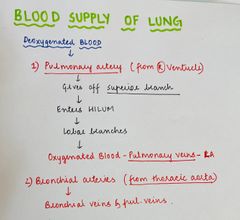
Back (Definition) |
|
|
|
Lymphatic drainage of the lung |
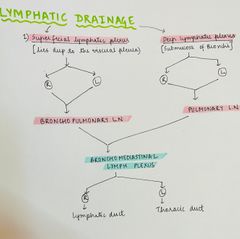
Back (Definition) |
|
|
|
Contents of the pulmonary plexus and supply |
Sympathetic and parasympathetic Forbes ( CN 10) Supply: visceral pleura, lung, pulmonary arterie and pulmonary vein |
|
|
|
Sensory innervation do the parietal pleura |
Intercostal nerve Phrenic nerve |
|
|
|
Pulmonary ligament |
Visceral pleural and parietal pleura become continuous at the root of the lung and form the pulmonary ligament |
|
|
|
Anatomical divisions of the plarietal pleura |
Costal pleura Diaphragmatic pleura Mediastinal pleural Cervical pleura |
|
|
|
Composition of the diaphragm |
Central tendinitis portion Outer muscular portion Lined by parietal pleura |
|
|
|
Diaphragm foramina |
T8: Vena cabal foramen (VPL): Vena cava, right phrenic nerve, lymph vessels T12: aortic hiatus: aorta, sympathetic chain, thoracic duct, azygous duct, subcostal nerve Posteriorly: oesophageal hiatus:( VOG) vagus, ousephagus, gastric vessels |
|
|
|
Arterial supply of the diaphragm |
Superior and inferior surfaces: phrenic arteries via aorta Superior surface: musculophrenic and cardiophrenic arteries from the internal thoracic arteries. |
|
|
|
Venous drainage of the diaphragm |
Superior surface:musculophrenic and cardiophrenic veins from the internal thoracic veins Inferior surface: inferior phrenic veins, left drains to left suprarenal veins Right to the IVC |
|
|
|
Lymphatic drainage of the diaphragm |
Superior surface: diaphragmatic LN INFERIOR surface: lumbar LN |
|
|
|
Diaphragm nerve supply |
Motor: entirely by phrenic C3-C5 Sensory: central part: phrenic nerve C3-C5 Peripheral : intercostal nerve T5-T11 and subcostal nerve T12 |
|
|
|
Heart borders |
RA: right border La: base and superior borders RV: anterior and inferior surface of the heart Luv: apex, left and diaphragmatic surface |
|
|
|
Heart borders |
Left: 2nd costal cartilage to 5th IC space in MCL Right: 3rd costal cartilage to 6th costal cartilage Superior: 3rd costal cartilage (right) to 2nd costal cartilage (left) Inferior: 6th costal cartilage ( left) to 5th IC space MCL (right) |
|
|
|
Coronary supply |
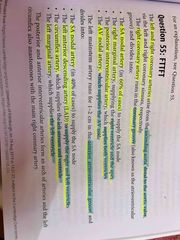
Back (Definition) |
|
|
|
Origin of the coronary arteries |
Arise from the ascending aorta distal to the aortic valve |
|
|
|
Venous systems of the heart |
Two venous systems 1) veins draining into the coronary sinus ➡️ right atrium 2) venae cordis minimae and anterior cardiac veins : drain directly into Ra |
|
|
|
Layers of the pericardium |
Serous layer: parietal and visceral layer- contain the pericardial fluid b/W the two Fibrous layer: attached to the diaphragm |
|
|
|
Arterial supply of the pericardium |
Internal thoracic artery |
|
|
|
Level at which the kidneys lie |
T12-L3 |
|
|
|
Arrangement of structures at the renal hilum |
Renal vein: most anterior Middle: renal artery Posterior: ureter |
|
|
|
Portal triad |
Common hepatic duct Petal vein Hepatic artery Enclosed by lesser one Tum at its lateral edge |
|
|
|
Calots triangle |
Lower edge of the liver CHD Cystic duct Contains cystic artery: supplies the GB |
|
|
|
Portal vein drains into which vein |
Hepatic vein |
|
|
|
Loves of the liver |
Right and left lobes ( contains the caudate and quadrate lobes- separated by ligamentum teres and venosum) |
|
|
|
Peritoneal reflections of the liver |
Coronary ligament Left triangular ligament Ligamentum teres |
|
|
|
Lesser omentum ligaments |
Hepatigastric ligament Heparoduodenal ligament |
|
|
|
What does the left feee edge of the lesser omentum contain |
Portal triad Lymph Nerve plexuses |
|
|
|
Level of pancreas |
L2 |
|
|
|
Sphincter of oddi |
Pancreatic duct combines with the common bile duct at the sphincter of oddi. Drains into second part of the duodenum |
|
|
|
Muscles contained by the rectum sheath |
Rectum abdominis Pyramidalalis Superior and inferior epigastric vessels Lymphatics Central tami of T7- T12 |
|
|
|
Muscles contained by the rectum sheath |
Rectum abdominis Pyramidalalis Superior and inferior epigastric vessels Lymphatics Central tami of T7- T12 |
|
|
|
Facia covering the abdomen |
Superficial fascia only ( 2 layers) Fatty layer ( Campers fascia) Membranous layer ( scarpas fascia) |
|
|
|
Nerve supply of the anterior abdominal wall |
Ventral tami of T7-L1 |
|
|
|
Boundaries of the triangle of petit |
Anteriorly: external oblique Inferior: iliac crest Posterior: lattisimus dorsi Site for giving TAP block |
|
|
|
Abdominal planes Horizontal planes |
L1: transpyloric- through pylori’s of the stomach L3: subcostal plane- lower border of the 10 th costal cartilage L5: transtubercular plane- through iliac tubercles |
|
|
|
Abdominal plane Verticalnplanes |
Median plane: through xiphoid process and pubic symphysis (lines Alba) midline, insertion of the rectus sheath. Mid clavicular plane: mid point of the clavicle to the mid inguinal point |
|
|
|
Location of the deep inguinal ring |
1cm above the mid point of the inguinal ligament. ( ASIS to Pubic tubercle) Superficial inguinal ring: 1 cm superb lateral to the pubic tubercle |
|
|
|
Location of the deep and superficial inguinal ring |
1cm above the mid point of the inguinal ligament. ( ASIS to Pubic tubercle) Superficial inguinal ring: 1 cm superb lateral to the pubic tubercle |
|
|
|
Contents of the inguinal canal in males |
Spermatic cord, ilioinguinal nerve Spermatic cord contents: - 3 arteries -3 nerves - 3 other structures: pampiniform plexus, vas deferens and lymph vessels |
|
|
|
Contents of the inguinal canal in females |
Round ligament of the uterus |
|
|
|
Contents of the inguinal canal in males |
Spermatic cord, ilioinguinal nerve Spermatic cord contents: - 3 arteries -3 nerves - 3 other structures: pampiniform plexus, vas deferens and lymph vessels |
|
|
|
Boundaries of the inguinal canal |
Anterior: EO aponeurosis Posterior: transversal is fascia Inferior: inguinal ligament Roof: IOM and transversest abdominis |
|
|
|
Relation of the hernia to the inferior epigastric vessels |
Direct inguinal hernia: medial to the inferior epigastric vessels
Imirect inguinal hernia: lateral to the inferior epigastric vessels |
|
|
|
Sympathetic nervous system: origin and course |
Origin: T1-L2/3 Course: leave SC via the anterior root and synapse with the autonomic ganglia in the paired sympathetic trunk. |
|
|
|
Sympathetic nervous system: origin and course |
Origin: T1-L2/3 Course: leave SC via the anterior root and synapse with the autonomic ganglia in the paired sympathetic trunk. |
|
|
|
Neurotransmitters at sympathetic ganglia |
Pre ganglionic fibres: short, myelinated, ACh release Post ganglionic fibres: long non myelinated, Nadr release. EXCEPT: sympathetic supply to sweat glands, skin and adrenal glands |
|
|
|
Formation of stellate ganglion |
Inferior cervical ganglion+ first thoracic ganglia |
|
|
|
Nerves arising from the stellate ganglion |
Lies on the first rib Gives rise to C7, C8 and T1 |
|
|
|
Course of parasympathetic nervous system |
Preganglionic fibres: long and synapse closer to the effector organ. Ach released at pre and post synapse |
|
|
|
Course of parasympathetic nervous system |
Preganglionic fibres: long and synapse closer to the effector organ. Ach released at pre and post synapse |
|
|
|
Cranial nerves that are parasympathetic |
CN 3- ciliary ganglion- eye CN 7: sphenopalatine and submandibular ganglion- lacrimal, nasal, pharyngeal and salivary glands CN 9: otic ganglion- parotid gland CN10: thorax and abdomen upto splenic flexure via anterior and posterior vagal trunks |
|
|
|
Action of PNS on the bladder |
Bladder relaxation |
|
|
|
Muscles supplied by the occulomotor nerve |
Parasympathetic fibres: Sphincter pupillary and ciliary muscle |
|
|
|
TrochLear nerve supplies which muscle |
Superplior oblique |
|
|
|
Abduscens nerve supplies which muscle |
Lateral rectus |
|
|
|
Only Division of trigeminal nerve which carries motor branches |
Mandibular branch |
|
|
|
Only Division of trigeminal nerve which carries motor branches |
Mandibular branch |
|
|
|
What is gasserion ganglion |
Thrigeminal nerve ganglion situated in the meckel’s cave in the floor of the petrous bone |
|
|
|
Branches of the gasserion ganglion |
Maxillary, mandibular and ophthalmic |
|
|
|
Lingual nerve is a branch of which nerve |
Largest branch Mandibular nerve ( br. of trigeminal nerve) |
|
|
|
Branches of the facial nerve |
Temporal, zygomatic, buccal, maxillary and cervical L |
|
|
|
Foramen a/W cranial nerves |
Foramen ovale : exit of mandibular division of CN 5 Foramen spinosum; MMA passes through this Stylomastoid foramen: exit of CN7 Jugular foramen: exit of CN 9, 10 and 11and IJV FORAMEN Magnum: medulla oblongata Hypoglossal canal: exit of CN 12 |
|
|
|
Supply of the tongue |
Sensory: anterior2/3: lingual, posterior 1/3 glossopharyngeal Motor- extrinsic and intrinsic muscles: hypoglossal nerve |
|
|
|
Lesions of the optic nerve |
Anterior to the optic chiasm: unilateral monocular blindness At the chiasm: bitemporal hemianopia Posterior to the chiasm: contralateral homonymous hemianopia |
|
|
|
Origin of CN |
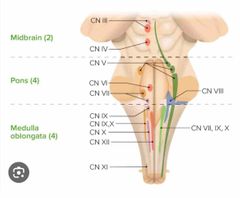
Back (Definition) |
|
|
|
Contents of the sacral canal |
Duran sac with the cauda equine, CSF and meninges, sacral nerves, coccygeal nerves and venous blood supply |
|
|
|
Contents of the sacral canal |
Dural sac with the cauda equine, CSF and meninges, sacral nerves, coccygeal nerves and venous blood supply |
|
|
|
Sacral hiatus formation |
Failure of fusion of the laminar arches of S5 Cornu: sacral spines of S4 Contents of the hiatus: sacral nerves from S5, coccygeal nerves. Covered by sacrococcygeal ligament |
|
|
|
Sutures of the skull |
Sagittal: between the frontal and parietal bones Coronal: between the two parietal bones Lambdoid: between the parietal and occipital bones |
|
|
|
Sutures of the skull |
Sagittal: between the frontal and parietal bones Coronal: between the two parietal bones Lambdoid: between the parietal and occipital bones |
|
|
|
Sutures of the skull |
Coronal: between the frontal and parietal bones Sagitta: between the two parietal bones Lambdoid: between the parietal and occipital bones |
|
|
|
What is bregma and lambda |
Bregma: Jx between the coronal and sagittal suture. It is the anterior fontanelle in infants Lambda: junction between lambda and Sagittal sutures |
|
|
|
Pterion |
Region of the skull where frontal, temporal, parietal and sphenoid bones join together MMA lies below the pterion Injury causes EDH |
|
|
|
Pterion |
Lies in the temporal fossa Region of the skull where frontal, temporal, parietal and sphenoid bones join together MMA lies below the pterion Injury causes EDH |
|
|
|
Sulci of the brain |
Central sulcus: b/W the frontal and parietal lobe Pre central gyrus : anterior to central sulcus- motor Postcentral gyrus: sensory Lateral sulcus: below which lies the temporal lobe and auditory area Broaca’s area/ motor speech: above the lateral sulcus Calcarine sulcus: occipital area- vision Diencephalon: thalamus and hypothalamus |
|
|
|
Contents of the midbrain |
Anterior part: crus cerebri Posterior part: tegmentum In b/W the two: substantia nigra Cerebral aqueduct: connecting 3rd and 4th ventricles |
|
|
|
Contents of the brain stem (hindbrain) |
Pons, medulla and the cerebellum Fourth ventricle |
|
|
|
Centres for upper limb reflexes |
Biceps reflex: C5-C6- MCN nerve- biceps jerk Brachioradialis reflex: C5-C6- MCN nerve- supinator jerk Triceps reflex -C6,C7- radial nerve triceps jerk |
|
|
|
Dermatomes UL |
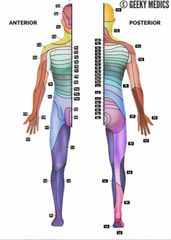
Back (Definition) |
|
|
|
Origin of the axillary artery |
From the subclavian artery at the lateral border of the first rib |
|
|
|
Parts of the axillary artery and origin of the brachial artery |
Three parts: 1st, 2nd and 3rd by pec minor Originates as brachial artery at the lower border of t. Major |
|
|
|
Branches of the brachial artery (Terminal branches) |
Radial and ulnar at the bicipital aponeurosis ( Anticubital fossa) |
|
|
|
Main component of the superficial and deep palmar arch |
superficial: radial artery deep palmar arch: ulnar artery |
|
|
|
Branches of the axillary artery |
Superior thoracic artery Subcostal artery Lateral thoracic artery Anterior circumflex humeral artery Posterior circumflex humeral artery |
SsLAPT |
|
|
Branches of the axillary artery |
Superior thoracic artery Subcostal artery Lateral thoracic artery Anterior circumflex humeral artery Posterior circumflex humeral artery |
SsLAPT |
|
|
Branches of the brachial artery |
Superior ulnar collateral artery Inferior ulnar collateral artery Deep brachial artery |
SID |
|
|
Assn. of the nerve with artery in the forearm |
Ulnar artery runs lateral to the ulnar nerve Radial artery runs medial to the superficial branch of the radial nerve. |
Arteries are protected by the nerves |
|
|
Venous drainage of the upper limb |
Superficial and deep system |
|
|
|
Venous drainage of the upper limb |
Superficial and deep system |
|
|
|
Deep venous drainage |
Brachial veins ( venae comitantes) |
|
|
|
Venous drainage of the upper limb |
Superficial and deep system |
|
|
|
Deep venous drainage |
Brachial veins ( venae comitantes) |
|
|
|
Superficial veins |
Basilic and Cephalic veins- connected by the median cubical vein at the anticubital fossa |
|
|
|
Venous drainage of the upper limb |
Superficial and deep system |
|
|
|
Deep venous drainage |
Brachial veins ( venae comitantes) |
|
|
|
Superficial veins |
Basilic (medial)and Cephalic (lateral) veins- connected by the median cubical vein at the anticubital fossa |
Basilic is at the BASE |
|
|
Formation of the axillary vein |
At the lower border of Tmajor Union of basilic vein and the brachial vein Ax. Vein lies medial to the ax. Artery |
|
|
|
What is waiters tip position |
D/t injury of the superficial part of the brachial plexus b/W head and neck |
|
|
|
What is waiters tip position |
D/t injury of the superficial part of the brachial plexus b/W head and neck |
|
|
|
Ulnar nerve injury produces what? |
Claw hand Damage to medial two lumbricles |
|
|
|
What is waiters tip position |
D/t injury of the superficial part of the brachial plexus b/W head and neck |
|
|
|
Ulnar nerve injury produces what? |
Claw hand Damage to medial two lumbricles |
|
|
|
Ulnar paradox |
Proximal ulnar nerve injury➡️ damage to flexor profundus➡️ damage produced is less evident( despite more injury) |
|
|
|
What is waiters tip position |
D/t injury of the superficial part of the brachial plexus b/W head and neck |
|
|
|
Ulnar nerve injury produces what? |
Claw hand Damage to medial two lumbricles |
|
|
|
Ulnar paradox |
Proximal ulnar nerve injury➡️ damage to flexor profundus➡️ damage produced is less evident( despite more injury) |
|
|
|
Carpal tunnel syndrome |
Median nerve involvement Sensory loss first ➡️ motor loss |
|
|
|
Nerve supply of the biceps and triceps |
Biceps: MCN- C5-C6 Triceps: radial nerve- C6-C8 |
|
|
|
Borders of the anticubital fossa |
Base: imaginary line connecting the hu metal epicondyles Medial: lateral border of probation teres Lateral: medial border of brachioradialis |
|
|
|
Borders of the anticubital fossa |
Base: imaginary line connecting the hu metal epicondyles Medial: lateral border of probation teres Lateral: medial border of brachioradialis |
|
|
|
Contents of the anticubital fossa |
Median nerve Radial nerve Tendon of the biceps brachii Brachial artery |
|
|
|
Incidence of pneumothorax in supraclavicular block |
5 % |
|
|
|
Risks in Infraclavicular block |
Pneumothorax: 1% Phrenic nerve palsy: 25% |
|
|
|
Complications of interscalene block |
Horners syndrome: 50-75 % Hoarseness of voice: 30% Phrenic nerve palsy: 10% |
|
|
|
Mc complication of axillary block |
Hematoma |
|
|
|
Loss of pronation |
Median nerve injury |
|
|
|
Loss of pronation |
Median nerve injury |
|
|
|
Loss of supination due to |
Radial nerve injury |
|
|
|
Deep fascia in the thigh and leg |
Thigh: fascia Lata Leg: crustal facia |
|
|
|
Compartments of the thigh |
Medial ( adductors) - Anterior ( hipflexors and leg extensors) Posterior ( hip extensors and leg flexors) attached to linea aspera of femur |
|
|
|
Compartments of the leg |
Anterior: leg extensor and foot flexor Lateral: foot extensor and leg flexor Posterior: superficial and deep |
|
|
|
Compartments in the leg and action on the foot |
Anterior compartment: inversion and Dorsi flexion of the foot Lateral: eversion Posterior superficial: plantar flexion of the foot Posterior deep: inversion and flexion of toes and ankles |
|
|
|
Origin and branches of femoral and Obturator arteries |
Femoral artery: originates from external IA, superficial and deep branch➡️medial and lateral cx femoral arteries Obturator artery: origin from internal iliac artery |
|
|
|
Formation of popliteal artery from femoral artery |
Adductor hiatus |
|
|
|
Formation of popliteal artery from femoral artery |
Adductor hiatus |
|
|
|
Branches of the popliteal artery |
Anterior tibial artery Posterior tibial artery ➡️ fibulae artery |
|
|
|
Ligaments of the ankle |
MEDIAL: Deltoid - insertions into talus, navicular and calcaneum LATERAL: 3 ligaments- anterior and posterior talofibular ligament Lateral calcaneufibular ligament |
|
|
|
Formation of ankle joint |
Distal tibia Fibula Talus |
|
|
|
Blood and nerve supply to the ankle |
Blood supply: anterior and posterior tibial arteries Nerve supply: tibial and deep fibulae nerves |
|
|
|
Arches of the foot |
Longitudinal arch: medial and lateral Transverse arch |
|
|
|
Arches of the foot |
Longitudinal arch: medial and lateral Transverse arch |
|
|
|
Structures in longitudinal arch |
Medial: navicular, calcaneum and medial 3 metatarsals Lateral: calcaneum, cuboid and lateral 2 metatarsals |
|
|
|
Arches of the foot |
Longitudinal arch: medial and lateral Transverse arch |
|
|
|
Structures in longitudinal arch |
Medial: navicular, calcaneum and medial 3 metatarsals Lateral: calcaneum, cuboid and lateral 2 metatarsals |
|
|
|
Transverse arch composition |
Calcaneum, cuboid and bases of metatarsals |
|
|
|
Subtalar joint acne it’s actions |
B/W talus and calcaneum Fx: inversion and eversion of the foot |
|
|
|
Root value for Knee jerk reflex Ankle reflex |
Knee jerk reflex: L2-L4 Ankle reflex: S1,S2 |
|
|
|
Nerves covered in lumbar plexus block |
Same as in 3-in -1 block Femoral LFCN Obturator |
|
|
|
Supply of uterine artery and uterine vein |
Uterine arteries: anterior division of internal iliac arteries Uterine vein: internal iliac vein |
|
|
|
Blood flow to the placenta |
500-800 ml/min |
|

